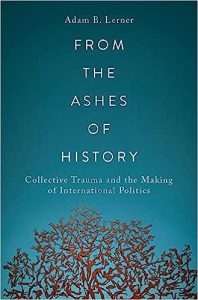In From the Ashes of History: Collective Trauma and the Making of International Politics, Adam Lerner argues that collective trauma – and the identity formation it precipitates – is a shaping force in international politics. Drawing on historical case studies from India, Israel and the US, Lerner makes a compelling case for incorporating a Trauma Studies approach into the discipline of International Relations, writes Kanchan Panday.
From the Ashes of History: Collective Trauma and the Making of International Politics. Adam B. Lerner. Oxford University Press. 2022.
 In From the Ashes of History: Collective Trauma and the Making of International Politics, Adam Lerner, draws our attention to a new ‘trauma turn’ (23) or trauma-informed way of doing International Relations (IR). Lerner makes a case for restructuring the discipline of IR away from the well-established event-based model, which mainly accounts for the immediate aftermath of conflict(s). In doing so, he points out the discrepancy in how IR scholarship fixates on traumatic events like wars, genocides and acts of terrorism while ignoring the long-term structural and psychological impact of such events on the people affected. Tracing the genealogy of trauma, the author highlights a pattern in policymaking wherein trauma often navigates the policy choices.
In From the Ashes of History: Collective Trauma and the Making of International Politics, Adam Lerner, draws our attention to a new ‘trauma turn’ (23) or trauma-informed way of doing International Relations (IR). Lerner makes a case for restructuring the discipline of IR away from the well-established event-based model, which mainly accounts for the immediate aftermath of conflict(s). In doing so, he points out the discrepancy in how IR scholarship fixates on traumatic events like wars, genocides and acts of terrorism while ignoring the long-term structural and psychological impact of such events on the people affected. Tracing the genealogy of trauma, the author highlights a pattern in policymaking wherein trauma often navigates the policy choices.
Lerner builds on the theoretical works of Cathy Caruth, Jenny Edkins, Emma Hutchinson and more to theorise that the narratives of identity are interlaced with the collective trauma of the community. He proposes that the “sociopolitical processing of mass violence (5)” in the present reflects the narratives of trauma identity and shapes the discourses of the future, often in the face of impending threat or violence. This argument unfolds in three chapters dedicated to theorisation, making a valuable contribution to the subdiscipline of International Political Theory by connecting the social-psychological components of violence to IR theory. Such theorisation brings the disciplines of IR and Trauma Studies closer to effective interdisciplinary collaboration.
The narratives of identity are interlaced with the collective trauma of the community.
The book contains three case studies of India, Israel and the US to reflect on the theory’s potential implications by examining their respective foreign and domestic policy choices. Through the case studies, Lerner elaborates on how collective trauma supplemented the policy choices of each state’s political elites. Another ambitious claim is that the collective trauma argument helps destabilise the “taken-for-granted concepts” (12) like war and security in IR. Moving away from the positivist paradigm, the author relies on historiography and hermeneutics for an intertextual analysis that allows for alternative explanations situated in collective trauma.
How collective trauma supplemented the policy choices of each state’s political elites.
The scholarship on trauma has shown that in the aftermath of traumatic events, the trauma becomes a mode of identification for the group and helps create “us” and “them” binaries. As argued in the first case study, the collective trauma—of deprivation, poverty and discrimination—united an ethnically, religiously and geographically diverse colonial India. The Indian nationalists of the late 19th and early 20th centuries espoused these ideas to refer to the lost agency of Indian cosmopolitan elites. However, during the Swadeshi movement of 1905, the message of economic consciousness was dispersed to the masses through literary symbols and performances (104). The collective trauma of India’s political economy later became the basis of its nationalist movement under Gandhi.
In the aftermath of traumatic events, the trauma becomes a mode of identification for the group and helps create “us” and “them” binaries.
Autarky (or national economic self-sufficiency) was inherent in the economic models of the state’s political elites, regardless of their ideological disposition. The author argues that in independent India, the political elites chose autarky as the suitable model for development even while keeping the masses discontent, such as asking them to fast for half a day for the nation (133). Driven by his theoretical approach, the author assesses that the often employed “anti-colonial sentiment” argument does not reflect well on India’s specific nationalist politics and colonial experience.
Lerner devises the concept of “Victimhood Nationalism” to explain the strategy of the David Ben-Gurion Government.
In the Israeli case, the author makes a curious intervention, claiming that Israel’s political elites exploited the collective trauma of the Holocaust to further their political ambitions and national interests. Lerner devises the concept of “Victimhood Nationalism” to explain the strategy of the David Ben-Gurion Government, adopted during the famous 1961 Eichmann trial. The argument holds that while there was the trauma of the genocide committed by the Nazi German state, the Israeli state elites repressed it to focus their energies on state-building” (137) in the decade of 1950s.
However, the opposition from the right-wing Herut party necessitated the confrontation with the Holocaust trauma. Ben-Gurion’s government used the trial to unify the diverse Jewish communities by cultivating a sense of ‘victimhood nationalism’. It projected the Nazi trauma against the threat of Arab states, often portraying Egyptian Leader Gamal Abdel Nasser as Hitler. This indeed boosted the falling popularity of Ben-Gurion and his Mapai Party. However, Ben-Gurion also used this narrative to save and speed up the process of establishing amicable relations with the federal republic of Germany.
In the third case of the post-9/11 United States, the author changes the argument pattern to show that trauma scholarship has vast potential to reorganise the central tenets of IR. Lerner uses the trauma lens to decipher the impact of conversations around Post Traumatic Stress Disorder (PTSD) among war veterans in American society. He argues that in the US, the debates on PTSD resulted in the erasure of distance in geography and time for the American public. People saw the war encroaching on their homes from as far as Iraq and Afghanistan in the form of PTSD-suffering veterans, resulting in collective self-victimisation. The ignorance of the suffering of the millions in Iraq and Afghanistan paralleled the self-victimisation of US society.
People saw the war encroaching on their homes from as far as Iraq and Afghanistan in the form of PTSD-suffering veterans, resulting in collective self-victimisation.
The three case studies and the three chapters on theory are rich resources for thinking of alternative ways to theorise IR. However, the book is not without its shortcomings. The author uses the terms government and state interchangeably (152), a conflation obscuring the significance of political leadership changes. Lerner mentions selective mobilisation and inculcation of trauma by the state; however, it requires further clarification on how the elite strategises trauma for their political gain. He problematises the event-based model of IR, but at no point clarifies his understanding of how an alternative model could be introduced. The destabilisation argument is also exaggerated, as critical scholars have long questioned the spatiotemporal understanding of war. Lerner could also have said more about the role of political elites in mobilising selective trauma, specifically in the case of the United States. If elites shape the national narrative, the book assigns a benign role to this extraordinary power.
That said, Lerner is brilliant in challenging IR’s traditional, event-based approach. In the final chapter, he opens the door for bringing the newer dimension of trauma and narrative into the IR fold. The book is an accessible read, and its emphasis on interdisciplinary collaboration will enrich the next generation of IR scholars.
- Main Image Credit: Taifur Azam via Wikimedia Commons.
- This review first appeared at LSE Review of Books.
- Please read our comments policy before commenting.
- Note: This article gives the views of the author, and not the position of USAPP – American Politics and Policy, nor of the London School of Economics.
- Shortened URL for this post: https://bit.ly/3CQP9Bs






